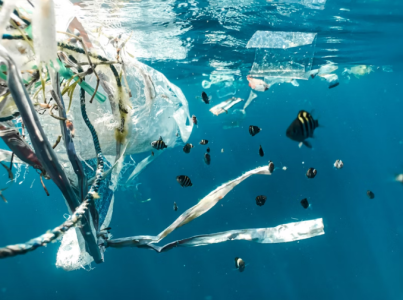Could nanoplastics be the next major health crisis?
- Replies 0
Sometimes, the biggest threats to our overall well-being and long-term health aren’t the ones we can easily see, touch, or recognize—they’re the ones quietly operating in the background, hidden in plain sight.
Scientific advances and breakthroughs in medical research are now beginning to uncover things inside our bodies that many of us never realized we were carrying, often without symptoms or warning signs.
What once seemed completely harmless or even went unnoticed just a few years ago is now being re-examined with a fresh sense of urgency and concern by experts.
And the implications of these findings could quietly ripple through nearly every part of our daily lives, especially when it comes to the decisions we make about our personal health and future well-being.
Nanoplastics are incredibly small fragments, often under 1,000 nanometers wide, and they’re created as larger plastics break down over time.
They’re found in everything from synthetic clothing fibers to water bottles, and they can easily pass through the air, water, and food systems.
The particles are so small that they can enter the human body without detection, sometimes lodging in places researchers are only beginning to understand. This includes tissues and organs that were once thought to be protected from outside contaminants.
In a recent study out of the University of New Mexico, Dr. Matt Campen and his team became the first to detect plastic in human brain tissue.
“That is a lot,” Campen told CBS News, estimating that the amount of plastic found could equal the mass of a plastic spoon.
The study raises critical questions about how such particles cross the blood-brain barrier and what damage they might do once inside. More troubling still, Campen added, “The fact that it’s getting worse over time is really the issue.”
While microplastics have been studied for years, the emerging threat of nanoplastics is gaining urgent attention due to their size and behavior in the body.
A study published in the Journal of the American Heart Association found elevated rates of heart disease, stroke, and type 2 diabetes among people living near nanoplastic-polluted oceans.
These correlations are not definitive proof of causation, but they are consistent across multiple environmental health indicators. The fact that these outcomes align with known effects of inflammation and vascular stress only adds to the concern.
Also read: Are microplastics in junk food quietly affecting your brain? Here’s what the research says—and what you can do about it
Campen’s team also found more nanoplastics in the brains of people diagnosed with dementia than in those without.
This finding, while preliminary, is prompting new research into whether plastics could contribute to cognitive decline.
Researchers stress that the particles themselves are problematic because of their physical presence and what they might carry.
The shape, size, and chemical composition of nanoplastics allow them to irritate tissue, lodge in arteries, and potentially act as delivery systems for toxins.
Dr. Leonardo Trasande of NYU is overseeing a massive long-term study of more than 64,000 children to assess the effects of plastic exposure from pregnancy onward. “Literally the particle is a problem—because it’s a foreign body in a tissue,” Trasande told CBS News.
His research has already linked plastic exposure to a broad range of issues including fertility challenges, premature birth, hormonal imbalances, and cognitive changes.
“If we use the same evidence standard,” he added, “we should be acting as fiercely on plastics in the food supply as we are on food dyes.”
Adults over 60 may be particularly vulnerable to the effects of nanoplastics due to weakened immune responses and increased risk of chronic conditions.
As people age, inflammation, heart disease, and cognitive decline become more prevalent—creating an environment where foreign particles could do more damage.
Additionally, older adults typically take more medications, raising questions about possible interactions with plastic contaminants. Scientists are now calling for further investigation into whether nanoplastics might reduce drug effectiveness or worsen side effects.
Also read: New study links everyday chemical to heart disease—what you should know
Despite the scale of the issue, experts emphasize that personal action still matters. Filtering your drinking water, reducing single-use plastic, and cleaning your home regularly with HEPA vacuums can all make a measurable difference.
Seafood and produce may also carry plastics, so proper washing and sourcing become key. Meanwhile, advocacy for policy change remains a powerful way to reduce the burden on the individual.
As research continues, many believe we’re only beginning to grasp the long-term impact of plastic exposure on human health.
The fact that these particles are nearly impossible to avoid makes it all the more critical to remain informed. Public health experts warn that the burden of proof should not delay precautionary action. The evidence is mounting, and in the words of Trasande, “These are toxic drug delivery systems.”
Read next: How much plastic is in your brain? New study reveals a shocking spoonful of truth!

Have you started taking steps to reduce plastic in your life? Are you concerned about how nanoplastics might be affecting your health or your family’s? Do you think the government is doing enough to regulate plastic pollution? Share your thoughts in the comments below—we want to hear from you.
Scientific advances and breakthroughs in medical research are now beginning to uncover things inside our bodies that many of us never realized we were carrying, often without symptoms or warning signs.
What once seemed completely harmless or even went unnoticed just a few years ago is now being re-examined with a fresh sense of urgency and concern by experts.
And the implications of these findings could quietly ripple through nearly every part of our daily lives, especially when it comes to the decisions we make about our personal health and future well-being.
Nanoplastics are incredibly small fragments, often under 1,000 nanometers wide, and they’re created as larger plastics break down over time.
They’re found in everything from synthetic clothing fibers to water bottles, and they can easily pass through the air, water, and food systems.
The particles are so small that they can enter the human body without detection, sometimes lodging in places researchers are only beginning to understand. This includes tissues and organs that were once thought to be protected from outside contaminants.
In a recent study out of the University of New Mexico, Dr. Matt Campen and his team became the first to detect plastic in human brain tissue.
“That is a lot,” Campen told CBS News, estimating that the amount of plastic found could equal the mass of a plastic spoon.
The study raises critical questions about how such particles cross the blood-brain barrier and what damage they might do once inside. More troubling still, Campen added, “The fact that it’s getting worse over time is really the issue.”
While microplastics have been studied for years, the emerging threat of nanoplastics is gaining urgent attention due to their size and behavior in the body.
A study published in the Journal of the American Heart Association found elevated rates of heart disease, stroke, and type 2 diabetes among people living near nanoplastic-polluted oceans.
These correlations are not definitive proof of causation, but they are consistent across multiple environmental health indicators. The fact that these outcomes align with known effects of inflammation and vascular stress only adds to the concern.
Also read: Are microplastics in junk food quietly affecting your brain? Here’s what the research says—and what you can do about it
Campen’s team also found more nanoplastics in the brains of people diagnosed with dementia than in those without.
This finding, while preliminary, is prompting new research into whether plastics could contribute to cognitive decline.
Researchers stress that the particles themselves are problematic because of their physical presence and what they might carry.
The shape, size, and chemical composition of nanoplastics allow them to irritate tissue, lodge in arteries, and potentially act as delivery systems for toxins.
Dr. Leonardo Trasande of NYU is overseeing a massive long-term study of more than 64,000 children to assess the effects of plastic exposure from pregnancy onward. “Literally the particle is a problem—because it’s a foreign body in a tissue,” Trasande told CBS News.
His research has already linked plastic exposure to a broad range of issues including fertility challenges, premature birth, hormonal imbalances, and cognitive changes.
“If we use the same evidence standard,” he added, “we should be acting as fiercely on plastics in the food supply as we are on food dyes.”
Adults over 60 may be particularly vulnerable to the effects of nanoplastics due to weakened immune responses and increased risk of chronic conditions.
As people age, inflammation, heart disease, and cognitive decline become more prevalent—creating an environment where foreign particles could do more damage.
Additionally, older adults typically take more medications, raising questions about possible interactions with plastic contaminants. Scientists are now calling for further investigation into whether nanoplastics might reduce drug effectiveness or worsen side effects.
Also read: New study links everyday chemical to heart disease—what you should know
Despite the scale of the issue, experts emphasize that personal action still matters. Filtering your drinking water, reducing single-use plastic, and cleaning your home regularly with HEPA vacuums can all make a measurable difference.
Seafood and produce may also carry plastics, so proper washing and sourcing become key. Meanwhile, advocacy for policy change remains a powerful way to reduce the burden on the individual.
As research continues, many believe we’re only beginning to grasp the long-term impact of plastic exposure on human health.
The fact that these particles are nearly impossible to avoid makes it all the more critical to remain informed. Public health experts warn that the burden of proof should not delay precautionary action. The evidence is mounting, and in the words of Trasande, “These are toxic drug delivery systems.”
Read next: How much plastic is in your brain? New study reveals a shocking spoonful of truth!
Key Takeaways
- University of New Mexico researchers found plastic in human brain tissue, estimating the amount could be equal to a plastic spoon.
- Studies link nanoplastics to increased risk of heart disease, stroke, diabetes, cognitive decline, and hormonal disruption.
- Dr. Leonardo Trasande is tracking 64,000 children to study long-term effects of plastic exposure on developmental and health outcomes.
- Experts recommend reducing personal plastic use, filtering water, avoiding high-risk foods, and staying informed about emerging research.







